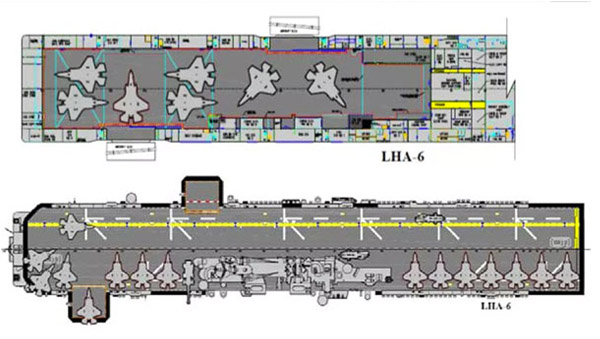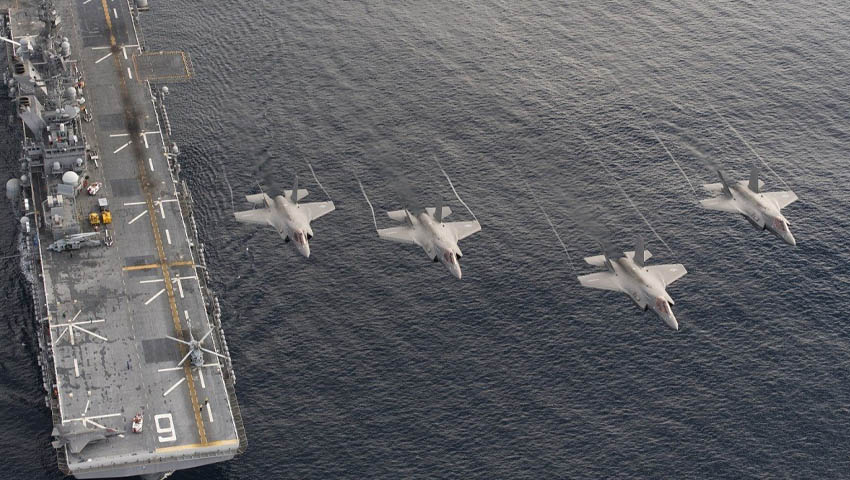As the capabilities of the F-35 Joint Strike Fighter variants continue to evolve, new CONOPs will evolve around the fifth-generation platform – the US Navy and Marine Corps team has developed the “Lightning Carrier” concept to provide the branches with a lower-tier naval aviation capability to support amphibious power projection operations.
Serving as the latest iteration of the Sea Control Ship (SCS) concept developed and conceptualised by the former US Navy Chief of Naval Operations and famed Second World War Admiral, Elmo Zumwalt, the Lightning Carrier and the corresponding sea control doctrines emerging around the platform combination are emerging as immense power projection potential.
While the aircraft carrier emerged as the apex of naval prestige and power projection at the end of the Second World War, the platform has evolved as technology has – with large fleet and supercarriers like the US Nimitz and Ford class, the UK Queen Elizabeth and Chinese Type 001 and follow on class vessels, the platforms have traditionally been the domain of major powers.
However, in recent years, nations throughout the Indo-Pacific have begun a series of naval expansion and modernisation programs, with traditional aircraft carriers and large-deck amphibious warfare ships serving as the core of their respective shift towards greater maritime power projection.
These developments have prompted the rapid development of the Lightning Carrier concept, combining the mobility and comparatively low cost of large-deck amphibious warfare ships and the increasing affordability of platforms like the F-35B short take-off, vertical landing (STOVL) serving as powerful alternatives for regional powers seeking to expand their long-range strike and maritime power projection capabilities.
Lightning Carrier concept
Combining the capability of the F-35 with large-deck amphibious warfare ships and ever-advancing tanker and airborne early warning capabilities is emerging as increasingly powerful force structures following the successful deployment of US Navy formations for combat operations to the Persian Gulf and the South China Sea in recent months.
The US variant of the Lightning Carrier combines a large-deck amphibious warfare ship like the Wasp or America class vessels and the F-35B – enabling the platforms to carry approximately 40 per cent of the firepower of a larger Nimitz or Ford class carrier. Enhancing the combat effectiveness and power projection capabilities of the Lightning Carrier concept is the ability of the F-35B to take off from the carrier and land on primitive airstrips ashore, while also dispersing the platform throughout an area of operations limiting broader force vulnerability.

It is planned that the US Navy’s large amphibious warfare ships will accommodate up to 20 F-35B Joint Strike Fighters, which would provide both the US Navy and US Marines with a potent force package. However, it is important to recognise that the Lightning Carrier concept is not without its limitations, as the development of early warning and control and tanker aircraft small enough to be stationed on the amphibious warfare ships is still somewhat limited, although progress is being made.
However, the US Marine Corps is optimistic about the capability brought by the Lightning Carrier, with the 2017 Marine Corps Aviation Plan stating, “While the amphibious assault ship will never replace the aircraft carrier, it can be complementary if employed in imaginative ways.”
“A Lightning Carrier, taking full advantage of the amphibious assault ship as a sea base, can provide the naval and joint force with significant access, collection and strike capabilities,” the Corps added.
Escorting guardians
Like the larger carrier strike groups, Lightning Carriers are inherently vulnerable to surface and subsurface attack – relatively unarmed without the carrier air wing beyond defensive weapons systems, the behemoths depend on a flotilla of protective and logistics support warships that enable the vessels to intervene and project presence and power throughout the globe.
US Navy Expeditionary Strike Groups would serve as the basis for the supporting elements of a Lightning Carrier force package and would need to be tailored to accommodate the shift away from purely amphibious operations to focus more directly on sea control and maritime power projection, including:
- Area-air defence guided missile cruiser/s: A US Navy CSG typically relies on one to two Ticonderoga Class guided missile cruisers supporting the Aegis combat system to direct long-range area-air defence, naval strike and long-range, land attack capabilities for the broader naval assets in the strike group.
- Destroyer Squadron (DESRON): Includes two-to-three Arleigh Burke Class guided missile destroyers used primarily for anti-aircraft and anti-submarine warfare, but which also carries Tomahawk missiles for long-range strike capability.
- Attack Submarine/s: Responsible for providing convoy protection and to screen the strike group against hostile surface ships and submarines, but which also carry Tomahawk missiles for long-range strike capability.
- Afloat Logistics Support Ship: A combined ammunition, oiler and supply ship providing logistics support – including fuel, dry stores and munitions support for the carrier and supporting CSG vessels.
Australia’s response?
For Australia, a nation defined by its relationship with traditionally larger, yet economically weaker, regional neighbours, the growing economic prosperity of the region and corresponding arms build-up, combined with ancient and more recent enmities, competing geo-political, economic and strategic interests, places the nation at the centre of the 21st century’s “great game”.
Further compounding Australia’s precarious position is an acceptance that “Pax Americana”, or the post-Second World War “American Peace”, is over and Australia will require a uniquely Australian approach and recognition that the nation is now solely responsible for the security of its national interests with key alliances serving a secondary, complementary role to the broader debate.
Today, strategic sea-lines-of-communication support over 90 per cent of global trade, a result of the cost-effective and reliable nature of sea transport. Indo-Pacific Asia is at the epicentre of the global maritime trade, with about US$5 trillion worth of trade flowing through the South China Sea and the strategic waterways and choke points of south-east Asia annually.
Meanwhile, the Indian Ocean and its critical global sea-lines-of-communication are responsible for more than 80 per cent of the world’s seaborne trade in critical energy supplies, namely oil and natural gas, which serve as the lifeblood of any advanced economy, including Australia, which has become vulnerable, as events in both the Middle East and south-east Asia, as a result of an increasingly assertive China.
Enhancing Australia’s capacity to act as an independent power, incorporating great power-style strategic economic, diplomatic and military capability, serves not only as a powerful symbol of Australia’s sovereignty and evolving responsibilities in supporting and enhancing the security and prosperity of Indo-Pacific Asia – shifting the public discussion away from the default Australian position of “it is all a little too difficult, so let’s not bother” will provide unprecedented economic, diplomatic, political and strategic opportunities for the nation.
Both fixed-wing naval aviation and amphibious capabilities are key force multipliers reshaping the region. The growing prevalence of fixed-wing naval aviation forces, particularly, serves to alter the strategic calculus and balance of power. Let us know your thoughts in the comments section below, or get in touch with









